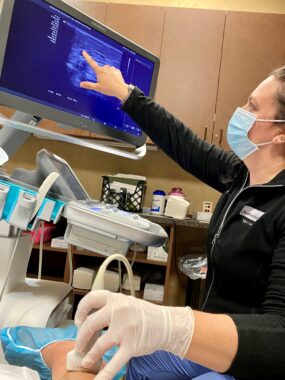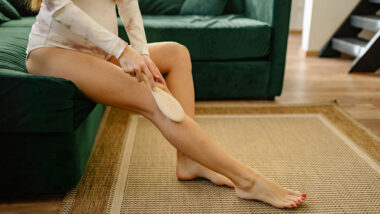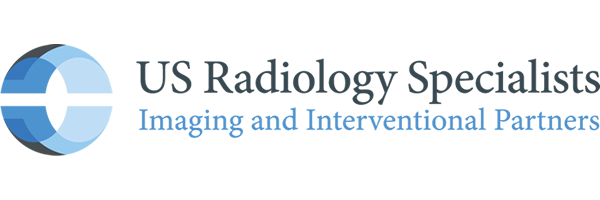Many people think of varicose veins as an unsightly but harmless condition. However, these surface-level issues often point to a concerning condition — venous disease, also called chronic venous disease or CVD. It’s estimated that over 30 million Americans have at least one form of venous disease, but many don’t know it.
Venous disease is a group of conditions that affect blood flow through the veins — which are the blood vessels that carry blood back to the heart. These conditions range from mild to potentially life-threatening. Without treatment, they can significantly lower your quality of life and increase your risk for other serious health conditions. Fortunately, there are things you can do to help prevent and treat venous disease.
Types and Causes of Venous Disease
Our leg veins consist of superficial veins, which course under the skin in the subcutaneous tissue, and deep veins, which course through the muscles. Both of these systems act as highways to bring blood from our feet and legs back toward our heart. If either system is not working well, blood can pool in the opposite direction toward the feet, which is called reflux.
Superficial venous disease is more common and occurs as a result of gradual vein dilation and valve dysfunction. The resulting vein reflux causes blood to pool in the leg, which can lead to the formation of varicose and spider veins as well as symptoms including aching, heaviness and a burning sensation.
Chronic venous disease can result in a wide range of issues including:
- Superficial thrombophlebitis — blood clots near the surface of the skin that are often painful
- Thrombosis and deep vein thrombosis (DVT) — blood clots in the arms, internal organs, legs or deep veins in the body that may break free and travel to the lungs (where they can be life-threatening)
- Varicose veins and spider veins — dilated and weak blood vessels that look like discolored lines or bulging areas under the skin
- Venous ulcers, also called venous stasis ulcers — open sores or wounds that are difficult to heal or that reoccur, related to chronic swelling from venous congestion
Several risk factors may increase your chance of developing venous disease, including:
- Birth control pills or hormone replacement therapy
- Developmental vein issues present at the time of birth
- Family history of venous disease
- Female gender
- Obesity or being overweight
- Hypertension (also called high blood pressure)
- Injury to the veins
- Participating in high-impact physical activities
- Pregnancy
- Sedentary lifestyle
- Sitting or standing for long periods
- Smoking or use of other tobacco products
Read More: Debunking 5 Common Vein Disease Myths
Vein Health Is Vital to Overall Health
Venous disease can affect veins throughout the body but most often those in the legs, including veins close to the skin and deep veins. Depending on which form of the disease you have, symptoms from affected veins may include:
- Heavy feeling in the legs
- Bulging veins
- Burning or itching sensations on the skin
- Chronic pain or discomfort in the legs
- Edema (a type of swelling)
- Leg cramps
- Skin discoloration, most commonly red/brown patches
Without treatment, symptoms of venous disease can be severe. They can interfere with daily activities and significantly decrease your quality of life. Additionally, untreated venous disease can cause several other serious health conditions. For example, venous ulcers increase the risk of an infection, which may lead to tissue death and the need for an amputation. Untreated venous disease can also become life-threatening if a blood clot travels to the lung, causing a pulmonary embolism. Because vein disease can impact your ability to participate in everyday tasks and activities you enjoy, it can also negatively impact your mental health.
Noninvasive Treatment for Venous Disease
While venous disease can cause serious issues if not treated, there are several things you can do to help prevent, manage or treat it. Lifestyle changes are one way to improve vein health, including:
- Avoid or quit smoking and the use of other tobacco products
- Drink enough water daily
- Eat a Mediterranean-style diet low in sodium
- Engage in daily exercise
- Maintain a healthy weight
There are also noninvasive treatments available. One of the most common noninvasive treatments for chronic venous insufficiency is wearing compression stockings, socks or bandages to encourage proper blood flow. If you’re pregnant, your provider may recommend compression stockings to manage swelling and pain and help prevent varicose and spider vein formation.
Other noninvasive treatments include elevating your legs when sitting or lying down and compression pumps to massage excess fluid from the legs.
Minimally Invasive Treatment Options
When medical treatments are not enough, there are effective, minimally invasive treatment options for vein disease, including:
- Endovenous laser treatment (EVLT), also called endovenous laser ablation — an image-guided, interventional radiology (IR) procedure that uses a laser to close damaged veins and reroute blood flow through healthy veins
- Sclerotherapy — an image-guided, IR procedure to inject a solution that closes up spider veins and varicose veins, causing them to shrink
- Inferior vena cava (IVC) filter — a small filter placed in the vein to prevent blood clots from traveling to the lungs using IR
- Thrombectomy (also known as DVT therapy) — another image-guided, IR procedure where medication to break up a blood clot is delivered directly to the site of the clot
Read More: This Is Why I Chose CR for Vein Treatment
Proactive Vein Care
Being proactive about vein care can help decrease symptoms and prevent serious complications of venous disease. The experts at Charlotte Radiology Vein Centers offer a wide range of imaging and interventional procedures to help diagnose, manage and treat all forms of venous disease before it slows you down.



